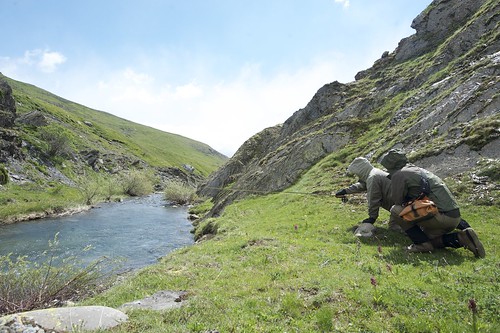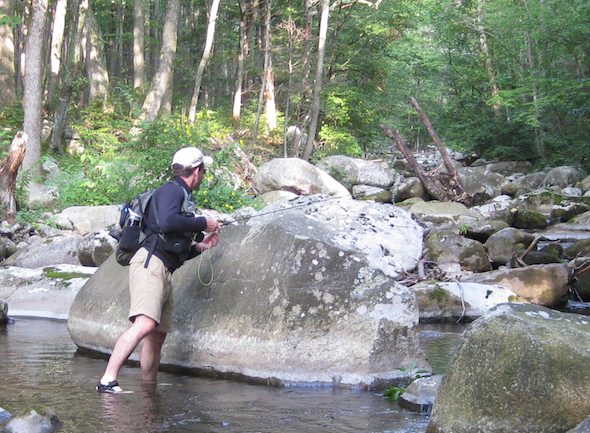
Wild trout are spooky. Everyone who fishes for them learns this, but sometimes the degree to which you have to be sneaky is much greater than you’d think. In certain conditions, especially in late summer when the water is low and clear, it is absolutely NOT crazy to have to crawl (on hands and knees and maybe on your belly) up to the spot where you’ll cast in order to avoid scattering the fish in that pool.
The image above is from a post about stealth on the Orvis News blog. That shot looks like it’s from some beautiful place out west. If that were an east coast brook trout stream, it would look more like this:

Rather than a nice open grassy spot, you would be slinking through the undergrowth of brambles, spider webs and poison ivy, trying not to puncture your waders on all the rocks while occasionally thumping the ground to scare away copperheads and timber rattlers. A hot humid June day, you’re schvitzing like a pig. That might be the worst case type of slinking. And all that to often end up where the only cast you can make will catch your fly on a tree branch. Or you bend a branch and it snaps back, swinging over the stream and scattering the brook trout in the pool right in front of you. And they’re gone.
It’s not always pretty out there.
When you do get to that spot without blowing it, hopefully there is enough water there to conceal your approach and enough room to make a decent backcast. That is a treat. But wild fish, especially native brook trout, are survivors. The spots where you think, “Ugh, I don’t want to deal with overhanging branches and deadfalls” are exactly the spots where the big wise fish like to hang out. Sometimes you can get creative and reach them with a bow and arrow cast or some other unconventional technique. Other times, the fish just win.
The Orvis blog post above mentions five tips for being stealthy when stalking fish:
- Blend in
- Don’t be flashy
- Keep a low profile
- Watch your shadows
- Slow down
This is a good opportunity to expand on their very short take on this subject…
Tips one through four could almost be considered variations of the same thing, which is to be invisible to the fish. Your silhouette, the color of your accessories, the bright yellow fiberglass rod you thought was cool, the bright white of the new sheepskin fly patch on your vest, the shiny silvery gadgets dangling from you — these will all scream out to fish that you are a potential predator.
Shadows are another aspect of being visible. On a cloudy day shadows are largely (but not totally) eliminated. But when the sun is out, you are confronted with two equally bad situations: 1) being in a position between the sun and the fish, which casts a shadow towards the fish, and 2) having the fish between you and the sun, which potentially illuminates you enough to make you very visible to the fish. The bottom line here is that you don’t want the sun, the fish and yourself to be in a line, which causes these two problems. You need to position yourself off that line. If that’s not possible, find another way to conceal yourself. Stay low or use the terrain, boulders or whatever else for concealment.

Take it seriously. Fish will scatter if they see you or your fly rod waving around. If that happens, move along. The fish in that pool will probably stay down for a while.
Taking the invisibility thing further is definitely pursued by some. There are people who paint their rods flat black and dress in drab or camo. Maybe there are even a few guys in Ghillie suits running around out there. Brook trout fishing is already bumping up to the lunatic fringe part of the spectrum in some people’s eyes, but if you want to go all the way to the nuts-O end, go for it. You might catch a few more fish.
